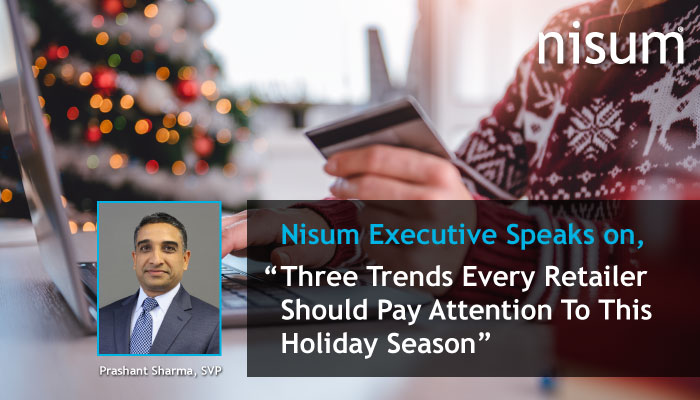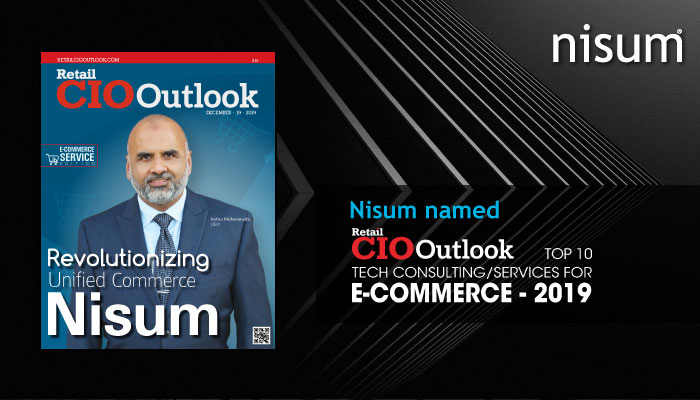In Nisum Senior Vice President, Prashant Sharma’s article he talks about retail technology trends affecting your digital commerce strategy this holiday season and beyond. The article also covers tactics that can create more immersive and seamless brand experiences for customers no matter their location, channel, or device.
You can read the full text below or view the article on LinkedIn here.

Three Trends Every Retailer Should Pay Attention To This Holiday Season
The holiday (shopping) season is upon us. Having spent the past many years consulting with some of the biggest retailers on their digital strategies, I’ve come to define trends of the holiday shopping season not by the latest tech gadget at the top of every must-have gift guide or the hottest toy flying off of the shelves; rather, I’ve found that this time of year is quite telling when it comes to the tech trends that will define a business for retailers in the coming year and beyond.
What are some of the trends we’re noticing this year? Read on for our top three tech trends defining this holiday season that every retailer should consider for their own strategies in 2020.
Get your backend in order.
There’s no time like the holiday shopping season for retailers when it comes to dealing with returns, exchanges, store credits, and the like. Consumers simply will not tolerate a scenario in which, for example, they receive a merchandise credit that they can use in-store, but not online. Or a scenario in which they bought something online and can’t return it in-store. Or any number of different scenarios in which their experience is not seamless because backend inventory or merchandising systems can’t talk to one another.
It’s no longer enough to provide solely a seamless front-end experience for consumers. Leading retailers have adopted a “unified commerce” approach, which simply stated, means that they have one system of record and as such, all of their backend processes communicate with one another. This means consumers can purchase, return and exchange across channels with zero friction.
Embrace the return of analog (strategically, of course).
There was a time when eCommerce was heralded as the death of brick-and-mortar. In actuality we’ve seen that the in-store experience is far from dead, in fact, many direct-to-consumer brands who started as digital natives have gone on to build a successful brick and mortar presence, for example, Warby Parker or Glossier. Even Amazon has invested in physical locations, from bookstores, “Go” convenience stores, to the 4-star shop in New York City.
This holiday season, Amazon has brought back the paper toy catalog, something that’s likely completely foreign to the entire generation born after 1995, but for generations before was a hallmark of the holiday shopping season.
The takeaway here for retailers is to think about the ways in which they can strategically create an immersive customer experience across both analog and digital channels. Amazon’s holiday catalog evokes a powerful nostalgia for Millennials, the generation that also happens to be spending more in-store and online than any other brand. However, the catalog is completely ineffective without an eCommerce presence that enables shoppers to purchase with the click of a button.
Start thinking about long-term strategies for next-generation technologies.
Artificial Intelligence (AI), Augmented reality (AR), and virtual reality (VR) has certainly dominated the retail conversation as buzzwords over the past five or so years, and many retailers use the holiday season to test out the latest activations of these technologies.
However, as the tech grows more sophisticated and becomes more accessible, retailers should be thinking of AI, AR and VR not as limited-time campaigns to “wow” consumers, but rather, as a viable long-term strategy for bridging the digital and the physical shopping experience. This could mean enabling eCommerce sites for customers to upload their own pictures to “try before they buy” or installing AR-equipped mirrors in store.
Another next-generation technology for retailers to keep top of mind is blockchain. While not mainstream yet, the transparency and security that blockchain offers have many applications for retail, from identity and fraud management to the elimination of third-party transaction fees, to better supply chain management. By understanding and implementing blockchain capabilities now, retailers can be ready when consumer demand and use becomes widespread.
If we drill down into one defining trend for retailers this holiday season, it is creating strategies and deploying tactics that create more immersive and seamless brand experiences for customers no matter their location, channel, or device. The explosion of ways in which shoppers can interact with brands has made it all the more important for retailers to create a cohesive, easy, and intuitive experience.



